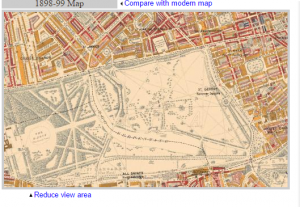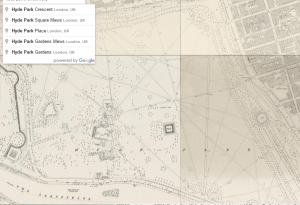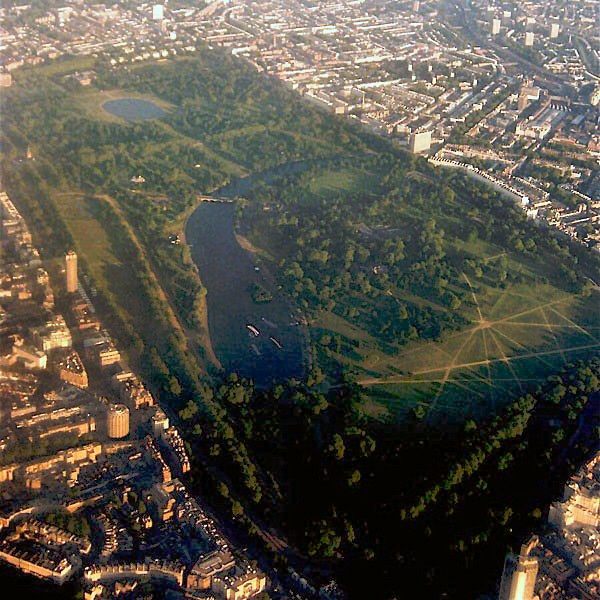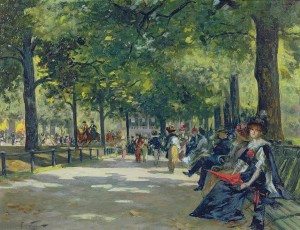Hyde Park, one of the must see sites in London. Being one of the only places in London full of lush green as far as the eye can see it was a get away from the hustle and bustle of city life.
The Park was first meant to be a private hunting ground for Henry VIII. In 1637 the Park was opened to the public by Charles I. During the Victorian Era, the Park was a place of leisure for the “fashionable world”. You could be at leisure in Hyde Park but not for long. According to W.S. Gilbert, one was to be on their toes in the Park where there was action on every corner. He says, “in the inner mind you must be observant, prepared to enjoy either the solitude of the crowd, or to catch the quick glance, the silvery music of momentary merriment, then have a few seconds of rapid, acute dialogue, or perhaps be beckoned into a carriage by a friend with space to spare.” A time in the Park was a social gathering of the most fashionable in London, including Queen Victoria herself. She hated London but loved to be in the Park (R.D.Blumenfeld). Max Schlesinger says” By far more interesting, and indeed unrivalled, is Rotten-row, the long broad road for horsemen, where, on fine summer evenings, all the youth, beauty, celebrity, and wealth of London may be seen on horse-back.” Hyde Park was inhabited by the beautiful people of London and it was readily seen by all who went there.

In Oscar Wilde’s The Picture Of Dorian Gray, the Park is talked about a few times. Lord Henry brings up the Park first in chapter three. Dorian begs the Lord to allow him to go with him as he wants to listen to him talk some more. Lord Henry responds:
“Ah! I have talked quite enough for to-day,” said Lord Henry, smiling. “All I want now is to look at life. You may come and look at it with me, if you care to.”
Readers of the Victorian era would make the connection to the active social area that was Hyde Park. Lord Henry, who had a view of life that fascinated Dorian Gray, wanted to observe the life that would inevitably be happening in the Park.
The Park is mentioned again in chapter four.Dorian is talking to Lord Henry again and mentions how the Lord has inspired Dorian to observe those in the Park, as he did in the chapter before. He also mentions the Park when he is talking about his new found love, an Actress named Sibyl Vane. He describes her as an extraordinary woman, different than those fashionable women who “ride in the park in the morning and chatter at tea-parties in the afternoon”. Lord Henry and Dorian believe that beauty is what one needs to strive for in life. The ever changing beauty of the actress night to night appeals to Dorian more than the fashionable and traditional women who socialize in Hyde Park.
The Park is mentioned another time in chapter five. Sibyl and her brother James are planning to go for walk. Sibyl suggests a walk in Hyde Park but James says “I am too shabby,” he answered, frowning. “Only swell people go to the park.” Hyde Park’s reputation and normal visitors would be known by the reader and this line would ring true to them. The line also lends itself to an overwhelming theme of the importance of beauty in the novel. It is important to multiple characters to look their best and to stay that way, including the park.
In chapter 11 the Park is brought up again. Basil had just been question Dorian about his morals and how much he has changed. He talks about a past liaison of Dorian’s named Lady Gwendolen. Lady Gwendolen was an upstanding citizen until Dorian. Now not ” a single decent woman in London now who would drive with her in the park” (chapter 11). Dorian has apparently influenced this woman so much that she would not be able to be in the upstanding place that is Hyde Park. Basil saying these words and with what we know about Hyde Park, we know that Lady Gwendolen must have changed in a way that made her unfashionable and not suitable for the Park. Dorian is back in the Park in chapter 18. He has joined a shooting-party with some elites of London. As they were shooting a hare had run in front of them into a bush where Sir Geoffrey Clouston then decided to shoot. When the shot rang out there were two screams, the one of the hare and the other of a man. In the end of the chapter we find out the man is none other then James Vane. James Vane had been stalking Dorian to get revenge for his sister death.When the hare had run past and Geoffrey Clouston readied himself to shoot at it, Dorian tried to get Geoffrey to not shoot at it. He had appreciated the look of the hare and did not want that to be taken away. When Clouston thought that to be ridiculous and shot anyway we are reminded that Dorian’s appreciation for beauty is much different then many others in the story. Vane himself had mentioned earlier in the story that he was too “shabby” to be in the Park. In a way it’s as if the Park has taken an extreme measure to retain it’s beauty when the “shabby” Vane is shot and killed instantly. In chapter 19 Lord Henry brings up the Park again when speaking to Dorian. In the end of the chapter Dorian is obviously not himself and Henry invites him to lunch and a visit to the Park the next day. Dorian does not want to go and asks if he must. Henry comes back and says of course he must, because “the Park is quite lovely this time of year” (chapter 19). Instead of saying something perhaps about spending time together or meeting with old friends it’s about seeing the beauty in the park because that is the only reason Henry wants to be there, to take in the natural beauty of the Park. The Park meant a lot to Dorian and Lord Henry alike. Mostly because the beauty that was there. Not only was the park naturally full of beautiful sights but only the beautiful people of London were there and both of our beauty obsessed characters knew that. They spent their time there to appreciate as much beauty as they could within England.
Work Cited
Blumenfeld, R.D.B. “Diary: June 27, 1887”. Victorian London. Lee Jackson. Web. 17 December 2015.
http://booth.lse.ac.uk/cgi-bin/do.pl?sub=view_booth_only&b.l=3&b.d.l=3&b.p.x=8532&b.p.y=9481&b.p.w=500&b.p.h=309&b.p.l=4&b.p.p.l=5&b.t.w=128&b.t.h=96&b.v.x=259&b.v.y=150
<http://www.victorianlondon.
https://en.wikisource.org/wiki/The_Picture_of_Dorian_Gray_(1891)/




